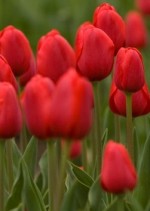 You only have to go to the supermarket in spring to see how popular daffodils and tulips are but they are only two of many bulbs that produce good cut flowers. Try hyacinths, grape hyacinths and even snowdrops in early spring; ornamental onions in mid spring. They are all easy to grow and make eye-catching arrangements alone or combined with other garden flowers and greenery. Grow them in a place like the vegetable garden where you won’t mind losing a few flowers when you cut them. No vegetable garden? Stick a few bulbs here and there at the back of the border. They will bloom, mature, and be gone by the time the other plants grow large.
You only have to go to the supermarket in spring to see how popular daffodils and tulips are but they are only two of many bulbs that produce good cut flowers. Try hyacinths, grape hyacinths and even snowdrops in early spring; ornamental onions in mid spring. They are all easy to grow and make eye-catching arrangements alone or combined with other garden flowers and greenery. Grow them in a place like the vegetable garden where you won’t mind losing a few flowers when you cut them. No vegetable garden? Stick a few bulbs here and there at the back of the border. They will bloom, mature, and be gone by the time the other plants grow large.
Here are some tips for growing and using these bulbs as cut flowers.

 Snowdrops (Galanthus nivalis)These early blooming beauties are small and petit but make an enchanting arrangement when placed in a small dainty vase that complements their delicate nature. Set the vase on a mirror in a place where you can enjoy the arrangement up close. Combine them with small pieces of pussy willow or witch hazel to vary the effect. If you like double flowers try the form “Flore Pleno’.
Snowdrops (Galanthus nivalis)These early blooming beauties are small and petit but make an enchanting arrangement when placed in a small dainty vase that complements their delicate nature. Set the vase on a mirror in a place where you can enjoy the arrangement up close. Combine them with small pieces of pussy willow or witch hazel to vary the effect. If you like double flowers try the form “Flore Pleno’.
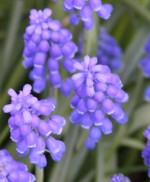
 Grape Hyacinths Purple, blue, pink and white varieties make mildly fragrant cut flowers that last 4-7 days. Cluster them together for the greatest impact using all one color or group equal numbers of different colors.
Grape Hyacinths Purple, blue, pink and white varieties make mildly fragrant cut flowers that last 4-7 days. Cluster them together for the greatest impact using all one color or group equal numbers of different colors.
 Hyacinths For abundant fragrance, try these beauties. They can be used in a traditional arrangement or displayed bulb and all.
Hyacinths For abundant fragrance, try these beauties. They can be used in a traditional arrangement or displayed bulb and all. 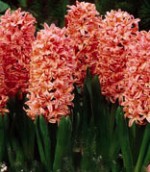 Just pull up the bulb, wash it off, and put it in a clear glass vase. If the traditional arrangement is more to your liking, consider wiring the stem to prevent it from drooping. Stick a piece of florist wire (available in craft stores) through the stem up to the tip, cutting the wire about 1” longer than the stem and bending it into the bottom. Hyacinths look well with other spring flowers and will last 3-7 days.
Just pull up the bulb, wash it off, and put it in a clear glass vase. If the traditional arrangement is more to your liking, consider wiring the stem to prevent it from drooping. Stick a piece of florist wire (available in craft stores) through the stem up to the tip, cutting the wire about 1” longer than the stem and bending it into the bottom. Hyacinths look well with other spring flowers and will last 3-7 days.

 Daffodils The premiere bulb for cut flower use hardly needs introduction but consider some of the small delicate varieties like ‘Hawera’ or Narcissus bulbocodium ‘Conspicuus’ (hoop petticoat). Cut daffodils when the buds are full and showing color. Cut the stems as long as you like but never take the foliage if you want the flowers to return the next year in full force. Resist the temptation to pair them with other flowers because the they have a slimy substance in their stems that oozes into the water and blocks the stems of other flowers. Daffodils have a vase life of 4-6 days and last the longest if arranged in shallow water. Click here to read my post on selecting daffodils.
Daffodils The premiere bulb for cut flower use hardly needs introduction but consider some of the small delicate varieties like ‘Hawera’ or Narcissus bulbocodium ‘Conspicuus’ (hoop petticoat). Cut daffodils when the buds are full and showing color. Cut the stems as long as you like but never take the foliage if you want the flowers to return the next year in full force. Resist the temptation to pair them with other flowers because the they have a slimy substance in their stems that oozes into the water and blocks the stems of other flowers. Daffodils have a vase life of 4-6 days and last the longest if arranged in shallow water. Click here to read my post on selecting daffodils.
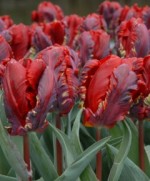
 Tulips Tulips are a variable bulb offering many different colors, stem lengths, bloom times, and forms. The simple ones give a down to earth look to an arrangement while the fancy kinds can make a bouquet look like it was the subject of a Dutch painting. Cut tulips when they are tight and 50% of the color is showing. The flowers tend to nod so roll bunches of flowers in newspaper to keep them upright during conditioning. Tulips can grow up to 1”/day after they are cut and will turn towards the light so plan your arrangement accordingly. Tulips have a vase life of 3-7 days. Click hear to read my post on selecting tulips.
Tulips Tulips are a variable bulb offering many different colors, stem lengths, bloom times, and forms. The simple ones give a down to earth look to an arrangement while the fancy kinds can make a bouquet look like it was the subject of a Dutch painting. Cut tulips when they are tight and 50% of the color is showing. The flowers tend to nod so roll bunches of flowers in newspaper to keep them upright during conditioning. Tulips can grow up to 1”/day after they are cut and will turn towards the light so plan your arrangement accordingly. Tulips have a vase life of 3-7 days. Click hear to read my post on selecting tulips.
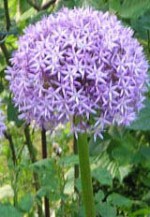
 Ornamental Onions (Allium) The group includes the flowers of chives (very pretty as a garnish) as well as the huge heads of Star of Persia. Yes, they have an onion odor when cut but it dissipates and doesn’t cause any problems. Cut when the individuals flowers are beginning to open for fresh arrangements or wait until they fade and become dry to use in dried arrangements. Fresh alliums have a vase life of 5-7 days but dried ones will last over a year or two. Click here to read my post on ornamental onions.
Ornamental Onions (Allium) The group includes the flowers of chives (very pretty as a garnish) as well as the huge heads of Star of Persia. Yes, they have an onion odor when cut but it dissipates and doesn’t cause any problems. Cut when the individuals flowers are beginning to open for fresh arrangements or wait until they fade and become dry to use in dried arrangements. Fresh alliums have a vase life of 5-7 days but dried ones will last over a year or two. Click here to read my post on ornamental onions.
These bulbs are relatively inexpensive and much cheaper than buying cut flowers. Since you can tuck them into small spaces in any garden area they don’t take a big investment in space. Plant in the fall and enjoy flowers through out the spring.
